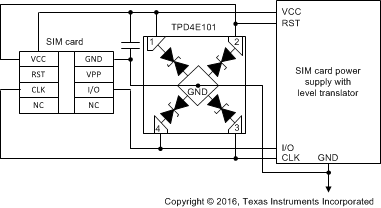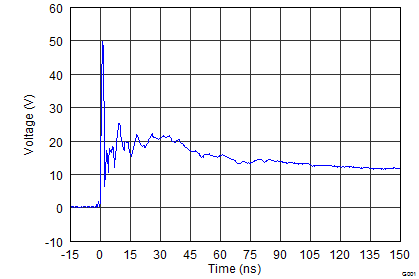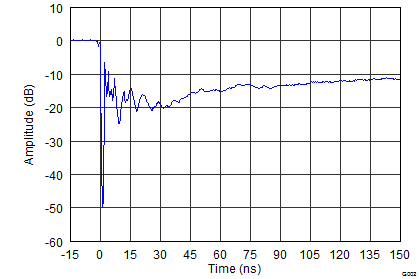SLVSBG0E August 2012 – April 2016 TPD4E101
PRODUCTION DATA.
- 1 Features
- 2 Applications
- 3 Description
- 4 Revision History
- 5 Pin Configuration and Functions
- 6 Specifications
- 7 Detailed Description
- 8 Application and Implementation
- 9 Power Supply Recommendations
- 10Layout
- 11Device and Documentation Support
- 12Mechanical, Packaging, and Orderable Information
Package Options
Mechanical Data (Package|Pins)
- DPW|4
Thermal pad, mechanical data (Package|Pins)
- DPW|4
Orderable Information
8 Application and Implementation
NOTE
Information in the following applications sections is not part of the TI component specification, and TI does not warrant its accuracy or completeness. TI’s customers are responsible for determining suitability of components for their purposes. Customers should validate and test their design implementation to confirm system functionality.
8.1 Application Information
When a system contains a human interface, it becomes vulnerable to large system-level ESD strikes that standard ICs cannot survive. TVS ESD protection diodes are typically used to suppress ESD at these interfaces. The TPD4E101 is a four-channel bidirectional TVS device , which is typically used to provide paths to ground for dissipating ESD events on signal or power lines between a human interface connector and a system. As the current from ESD passes through the device, only a small voltage drop is present across the diode structure. This is the voltage presented to the protected IC. The low RDYN of the triggered TVS holds this voltage, VCLAMP, to a tolerable level to the protected IC.
8.2 Typical Application
 Figure 10. Typical Application Schematic
Figure 10. Typical Application Schematic
8.2.1 Design Requirements
For this design example, the TPD4E101 will be used to protect the SIM card. For this application, the system parameters listed in Table 1 are known.
Table 1. Design Parameters
| DESIGN PARAMETER | VALUE |
|---|---|
| SIM card power supply voltage (Vcc) | 3.3 V or 5 V |
| Signal pins voltage range | 0 V to Vcc |
| Signal pins data rate | 1 Mbps to 20 Mbps |
| Required IEC 61000-4-2 ESD Protection | ±8-kV Contact / ±15-kV Air-Gap |
8.2.2 Detailed Design Procedure
To begin the design process, some parameters must be decided upon; the designer must make sure:
- Voltage range on the protected line must not exceed the reverse standoff voltage of the TVS diode(s) (VRWM).
- Operating frequency is supported by the I/O capacitance CIO of the TVS diode.
- IEC 61000-4-2 protection requirement is covered by the IEC performance of the TVS diode.
For this application, the power supply and signal voltage range is 0 to 3.3 V or to 5 V. The VRWM for the TVS is ±5.5 V; therefore, the bidirectional TVS will not break down during normal operation, and therefore normal operation of the power supply and signal pins will not be effected. Either a unidirectional or bidirectional ESD clamping device is good for this application.
Next, consider the data rate of the signal. The SIM card clock frequency that the signals run off is from 1 MHz to 20 MHz; ensure that the TVS I/O capacitance will not distort this signal by filtering it with the inherent capacitance. With TPD4E101's typical capacitance of 4.8 pF, which leads to a typical 3-dB bandwidth of 700 MHz, each channel has sufficient bandwidth to pass the signal without distorting it.
Finally, the human interface in this application requires the Level 4 IEC 61000-4-2 system-level ESD protection (±8-kV Contact and ±15-kV Air-Gap). The TPD4E101 can survive at least ±15-kV Contact/ ±15-kV Air-Gap. Therefore, the device can provide sufficient ESD protection for the interface. For any TVS diode to provide its full range of ESD protection capabilities, as well as to minimize the noise and EMI disturbances the board will see during ESD events, it is crucial that a system designer uses proper board layout of their TVS ESD protection diodes. See the Layout Example for instructions on properly laying out TPD4E101.
8.2.3 Application Curves
 Figure 11. IEC 61000-4-2 Clamping Voltage, 8-kV Contact
Figure 11. IEC 61000-4-2 Clamping Voltage, 8-kV Contact
 Figure 12. IEC 61000-4-2 Clamping Voltage, –8-kV Contact
Figure 12. IEC 61000-4-2 Clamping Voltage, –8-kV Contact